ABS CHEVROLET EXPRESS PASSANGER 2007 1.G Owners Manual
[x] Cancel search | Manufacturer: CHEVROLET, Model Year: 2007, Model line: EXPRESS PASSANGER, Model: CHEVROLET EXPRESS PASSANGER 2007 1.GPages: 458, PDF Size: 2.62 MB
Page 176 of 458
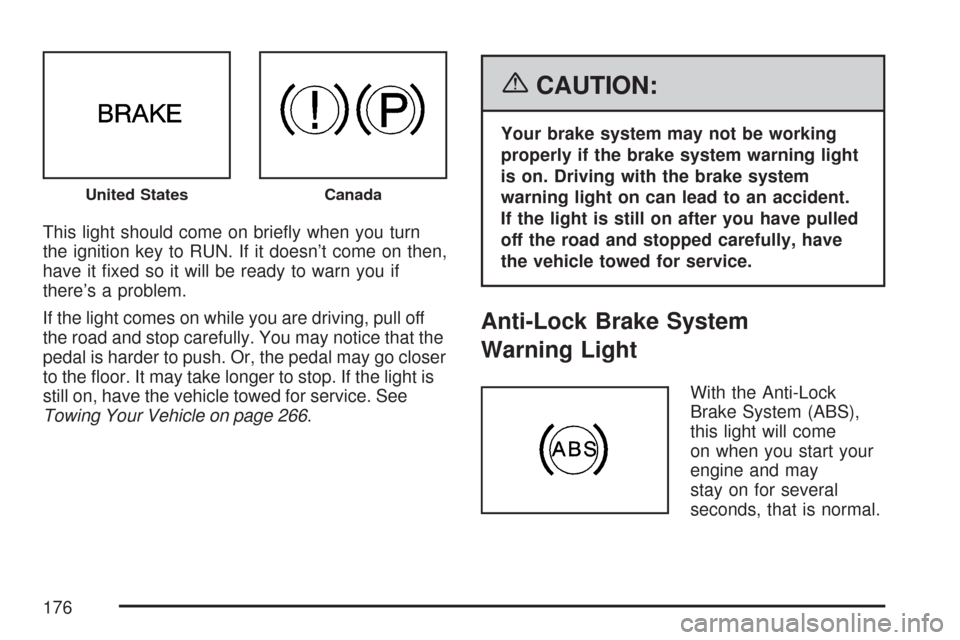
This light should come on brie’¼éy when you turn
the ignition key to RUN. If it doesnŌĆÖt come on then,
have it ’¼üxed so it will be ready to warn you if
thereŌĆÖs a problem.
If the light comes on while you are driving, pull off
the road and stop carefully. You may notice that the
pedal is harder to push. Or, the pedal may go closer
to the ’¼éoor. It may take longer to stop. If the light is
still on, have the vehicle towed for service. See
Towing Your Vehicle on page 266.
{CAUTION:
Your brake system may not be working
properly if the brake system warning light
is on. Driving with the brake system
warning light on can lead to an accident.
If the light is still on after you have pulled
off the road and stopped carefully, have
the vehicle towed for service.
Anti-Lock Brake System
Warning Light
With the Anti-Lock
Brake System (ABS),
this light will come
on when you start your
engine and may
stay on for several
seconds, that is normal.
United StatesCanada
176
Page 177 of 458
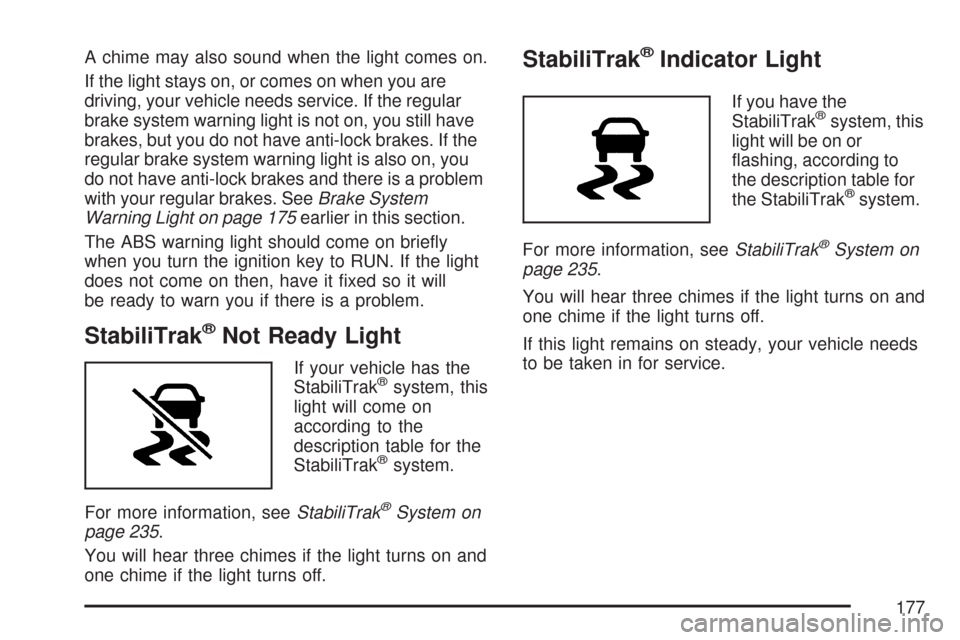
A chime may also sound when the light comes on.
If the light stays on, or comes on when you are
driving, your vehicle needs service. If the regular
brake system warning light is not on, you still have
brakes, but you do not have anti-lock brakes. If the
regular brake system warning light is also on, you
do not have anti-lock brakes and there is a problem
with your regular brakes. SeeBrake System
Warning Light on page 175earlier in this section.
The ABS warning light should come on brie’¼éy
when you turn the ignition key to RUN. If the light
does not come on then, have it ’¼üxed so it will
be ready to warn you if there is a problem.
StabiliTrak®Not Ready Light
If your vehicle has the
StabiliTrak®system, this
light will come on
according to the
description table for the
StabiliTrak
®system.
For more information, seeStabiliTrak
®System on
page 235.
You will hear three chimes if the light turns on and
one chime if the light turns off.
StabiliTrak®Indicator Light
If you have the
StabiliTrak®system, this
light will be on or
’¼éashing, according to
the description table for
the StabiliTrak
®system.
For more information, seeStabiliTrak
®System on
page 235.
You will hear three chimes if the light turns on and
one chime if the light turns off.
If this light remains on steady, your vehicle needs
to be taken in for service.
177
Page 227 of 458
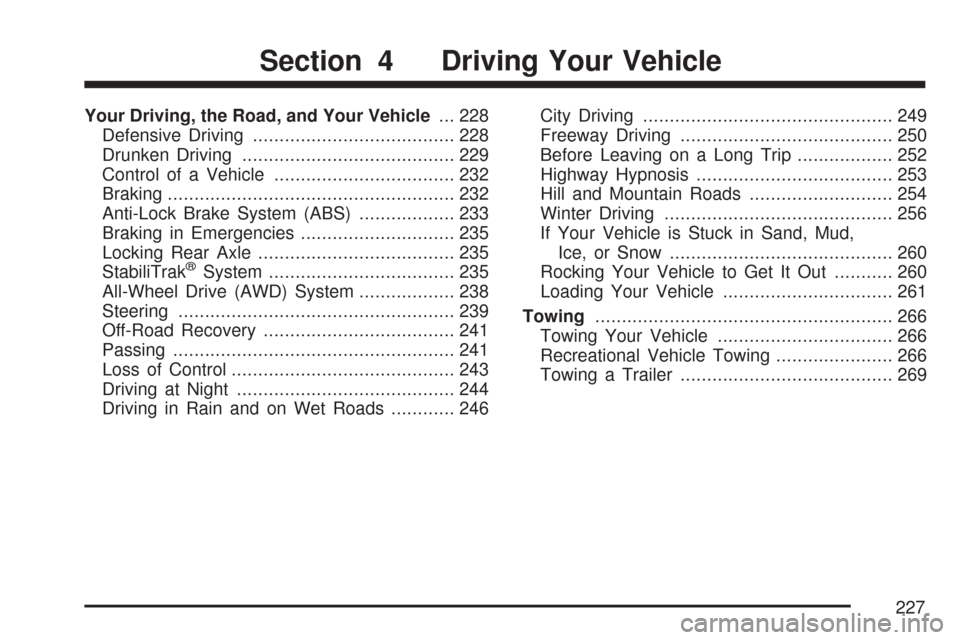
Your Driving, the Road, and Your Vehicle... 228
Defensive Driving...................................... 228
Drunken Driving........................................ 229
Control of a Vehicle.................................. 232
Braking...................................................... 232
Anti-Lock Brake System (ABS).................. 233
Braking in Emergencies............................. 235
Locking Rear Axle..................................... 235
StabiliTrak
®System................................... 235
All-Wheel Drive (AWD) System.................. 238
Steering.................................................... 239
Off-Road Recovery.................................... 241
Passing..................................................... 241
Loss of Control.......................................... 243
Driving at Night......................................... 244
Driving in Rain and on Wet Roads............ 246City Driving............................................... 249
Freeway Driving........................................ 250
Before Leaving on a Long Trip.................. 252
Highway Hypnosis..................................... 253
Hill and Mountain Roads........................... 254
Winter Driving........................................... 256
If Your Vehicle is Stuck in Sand, Mud,
Ice, or Snow.......................................... 260
Rocking Your Vehicle to Get It Out........... 260
Loading Your Vehicle................................ 261
Towing........................................................ 266
Towing Your Vehicle................................. 266
Recreational Vehicle Towing...................... 266
Towing a Trailer........................................ 269
Section 4 Driving Your Vehicle
227
Page 233 of 458
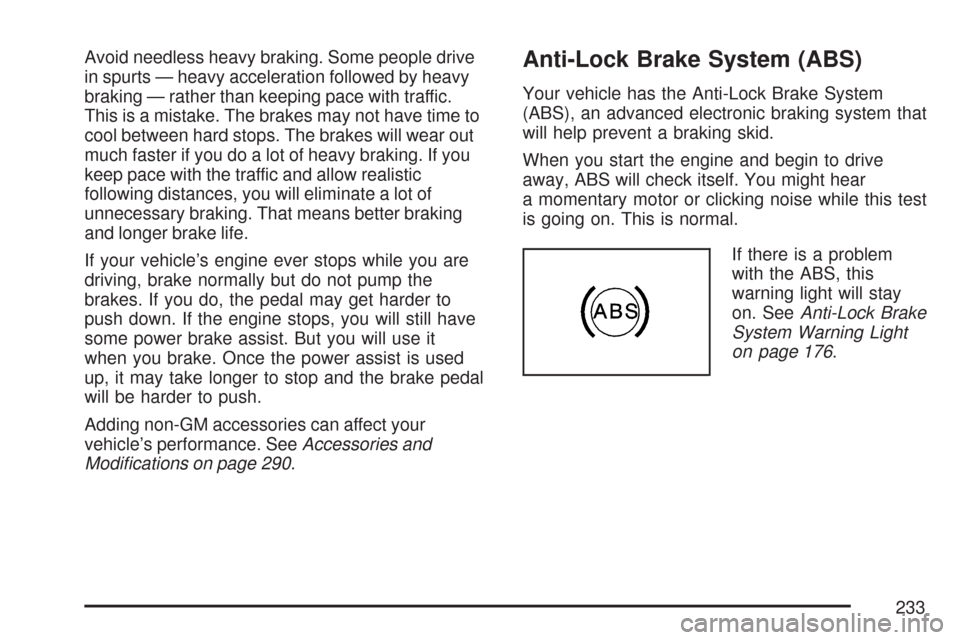
Avoid needless heavy braking. Some people drive
in spurts ŌĆö heavy acceleration followed by heavy
braking ŌĆö rather than keeping pace with traffic.
This is a mistake. The brakes may not have time to
cool between hard stops. The brakes will wear out
much faster if you do a lot of heavy braking. If you
keep pace with the traffic and allow realistic
following distances, you will eliminate a lot of
unnecessary braking. That means better braking
and longer brake life.
If your vehicleŌĆÖs engine ever stops while you are
driving, brake normally but do not pump the
brakes. If you do, the pedal may get harder to
push down. If the engine stops, you will still have
some power brake assist. But you will use it
when you brake. Once the power assist is used
up, it may take longer to stop and the brake pedal
will be harder to push.
Adding non-GM accessories can affect your
vehicleŌĆÖs performance. SeeAccessories and
Modi�cations on page 290.Anti-Lock Brake System (ABS)
Your vehicle has the Anti-Lock Brake System
(ABS), an advanced electronic braking system that
will help prevent a braking skid.
When you start the engine and begin to drive
away, ABS will check itself. You might hear
a momentary motor or clicking noise while this test
is going on. This is normal.
If there is a problem
with the ABS, this
warning light will stay
on. SeeAnti-Lock Brake
System Warning Light
on page 176.
233
Page 234 of 458
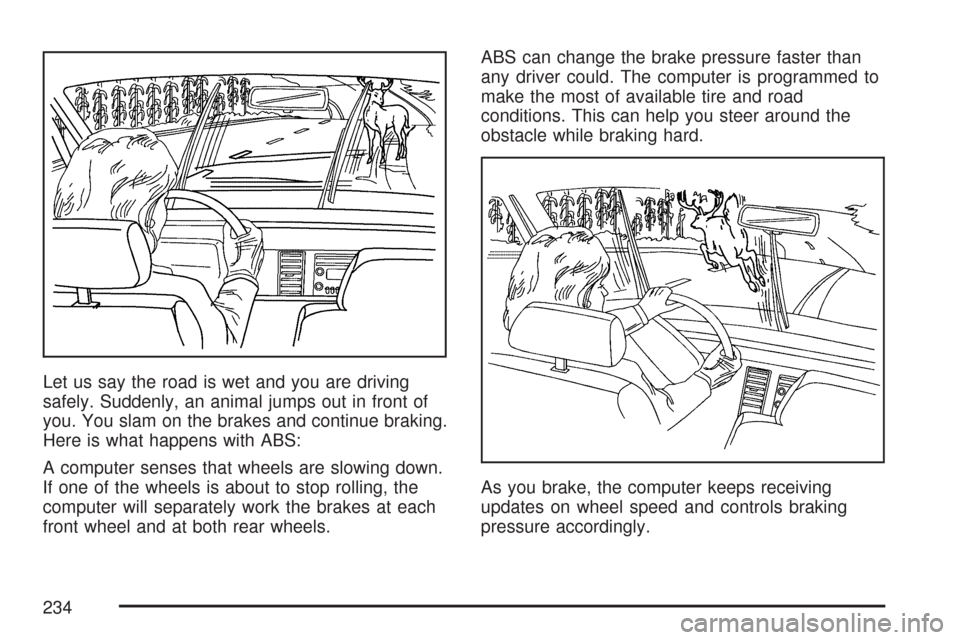
Let us say the road is wet and you are driving
safely. Suddenly, an animal jumps out in front of
you. You slam on the brakes and continue braking.
Here is what happens with ABS:
A computer senses that wheels are slowing down.
If one of the wheels is about to stop rolling, the
computer will separately work the brakes at each
front wheel and at both rear wheels.ABS can change the brake pressure faster than
any driver could. The computer is programmed to
make the most of available tire and road
conditions. This can help you steer around the
obstacle while braking hard.
As you brake, the computer keeps receiving
updates on wheel speed and controls braking
pressure accordingly.
234
Page 235 of 458
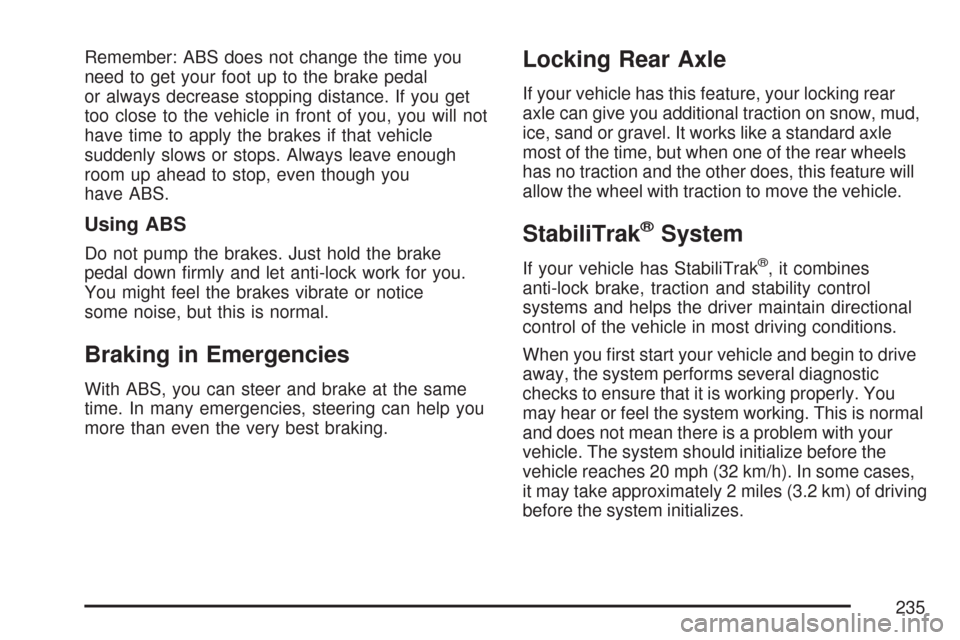
Remember: ABS does not change the time you
need to get your foot up to the brake pedal
or always decrease stopping distance. If you get
too close to the vehicle in front of you, you will not
have time to apply the brakes if that vehicle
suddenly slows or stops. Always leave enough
room up ahead to stop, even though you
have ABS.
Using ABS
Do not pump the brakes. Just hold the brake
pedal down ’¼ürmly and let anti-lock work for you.
You might feel the brakes vibrate or notice
some noise, but this is normal.
Braking in Emergencies
With ABS, you can steer and brake at the same
time. In many emergencies, steering can help you
more than even the very best braking.
Locking Rear Axle
If your vehicle has this feature, your locking rear
axle can give you additional traction on snow, mud,
ice, sand or gravel. It works like a standard axle
most of the time, but when one of the rear wheels
has no traction and the other does, this feature will
allow the wheel with traction to move the vehicle.
StabiliTrak®System
If your vehicle has StabiliTrak®, it combines
anti-lock brake, traction and stability control
systems and helps the driver maintain directional
control of the vehicle in most driving conditions.
When you ’¼ürst start your vehicle and begin to drive
away, the system performs several diagnostic
checks to ensure that it is working properly. You
may hear or feel the system working. This is normal
and does not mean there is a problem with your
vehicle. The system should initialize before the
vehicle reaches 20 mph (32 km/h). In some cases,
it may take approximately 2 miles (3.2 km) of driving
before the system initializes.
235
Page 244 of 458
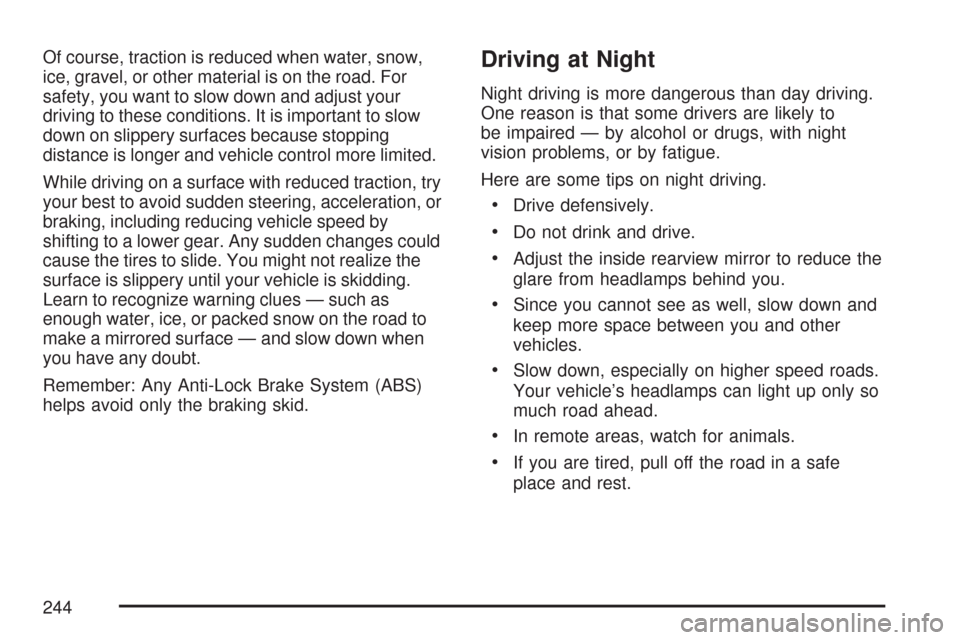
Of course, traction is reduced when water, snow,
ice, gravel, or other material is on the road. For
safety, you want to slow down and adjust your
driving to these conditions. It is important to slow
down on slippery surfaces because stopping
distance is longer and vehicle control more limited.
While driving on a surface with reduced traction, try
your best to avoid sudden steering, acceleration, or
braking, including reducing vehicle speed by
shifting to a lower gear. Any sudden changes could
cause the tires to slide. You might not realize the
surface is slippery until your vehicle is skidding.
Learn to recognize warning clues ŌĆö such as
enough water, ice, or packed snow on the road to
make a mirrored surface ŌĆö and slow down when
you have any doubt.
Remember: Any Anti-Lock Brake System (ABS)
helps avoid only the braking skid.Driving at Night
Night driving is more dangerous than day driving.
One reason is that some drivers are likely to
be impaired ŌĆö by alcohol or drugs, with night
vision problems, or by fatigue.
Here are some tips on night driving.
ŌĆóDrive defensively.
ŌĆóDo not drink and drive.
ŌĆóAdjust the inside rearview mirror to reduce the
glare from headlamps behind you.
ŌĆóSince you cannot see as well, slow down and
keep more space between you and other
vehicles.
ŌĆóSlow down, especially on higher speed roads.
Your vehicleŌĆÖs headlamps can light up only so
much road ahead.
ŌĆóIn remote areas, watch for animals.
ŌĆóIf you are tired, pull off the road in a safe
place and rest.
244
Page 257 of 458
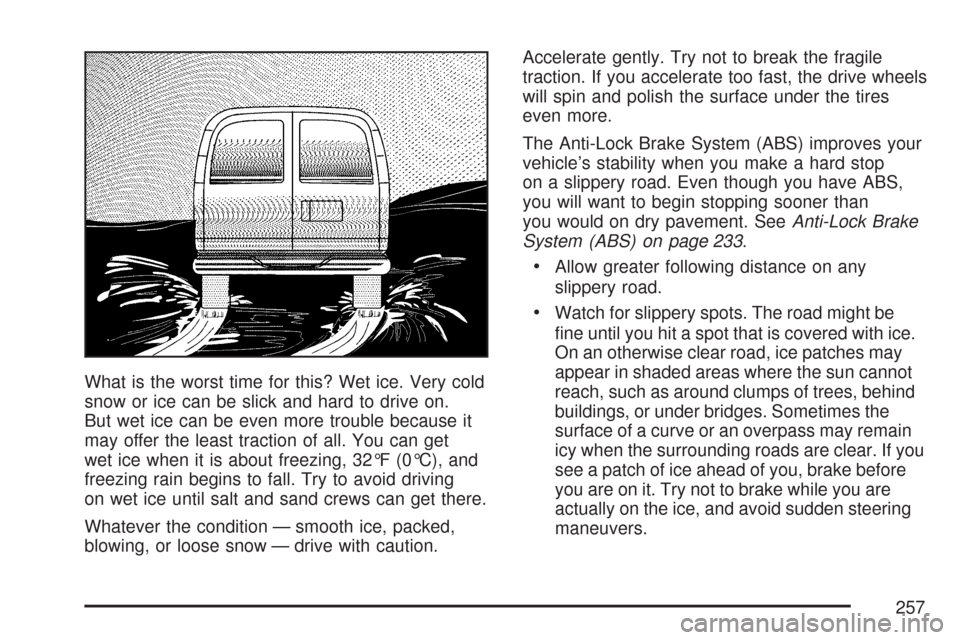
What is the worst time for this? Wet ice. Very cold
snow or ice can be slick and hard to drive on.
But wet ice can be even more trouble because it
may offer the least traction of all. You can get
wet ice when it is about freezing, 32┬░F (0┬░C), and
freezing rain begins to fall. Try to avoid driving
on wet ice until salt and sand crews can get there.
Whatever the condition ŌĆö smooth ice, packed,
blowing, or loose snow ŌĆö drive with caution.Accelerate gently. Try not to break the fragile
traction. If you accelerate too fast, the drive wheels
will spin and polish the surface under the tires
even more.
The Anti-Lock Brake System (ABS) improves your
vehicleŌĆÖs stability when you make a hard stop
on a slippery road. Even though you have ABS,
you will want to begin stopping sooner than
you would on dry pavement. SeeAnti-Lock Brake
System (ABS) on page 233.
ŌĆóAllow greater following distance on any
slippery road.
ŌĆóWatch for slippery spots. The road might be
’¼üne until you hit a spot that is covered with ice.
On an otherwise clear road, ice patches may
appear in shaded areas where the sun cannot
reach, such as around clumps of trees, behind
buildings, or under bridges. Sometimes the
surface of a curve or an overpass may remain
icy when the surrounding roads are clear. If you
see a patch of ice ahead of you, brake before
you are on it. Try not to brake while you are
actually on the ice, and avoid sudden steering
maneuvers.
257
Page 285 of 458
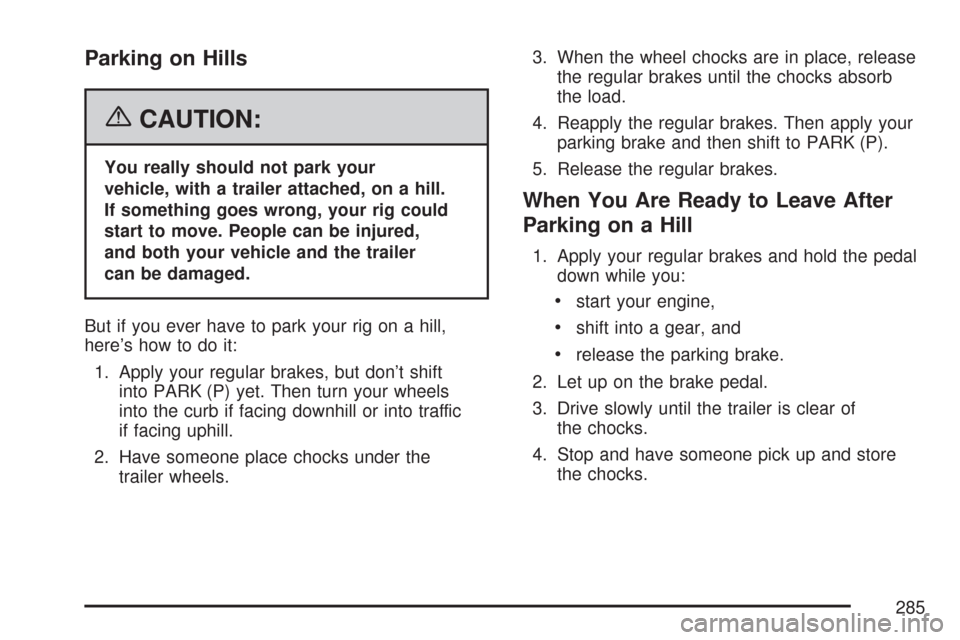
Parking on Hills
{CAUTION:
You really should not park your
vehicle, with a trailer attached, on a hill.
If something goes wrong, your rig could
start to move. People can be injured,
and both your vehicle and the trailer
can be damaged.
But if you ever have to park your rig on a hill,
hereŌĆÖs how to do it:
1. Apply your regular brakes, but donŌĆÖt shift
into PARK (P) yet. Then turn your wheels
into the curb if facing downhill or into traffic
if facing uphill.
2. Have someone place chocks under the
trailer wheels.3. When the wheel chocks are in place, release
the regular brakes until the chocks absorb
the load.
4. Reapply the regular brakes. Then apply your
parking brake and then shift to PARK (P).
5. Release the regular brakes.
When You Are Ready to Leave After
Parking on a Hill
1. Apply your regular brakes and hold the pedal
down while you:
ŌĆóstart your engine,
ŌĆóshift into a gear, and
ŌĆórelease the parking brake.
2. Let up on the brake pedal.
3. Drive slowly until the trailer is clear of
the chocks.
4. Stop and have someone pick up and store
the chocks.
285
Page 342 of 458
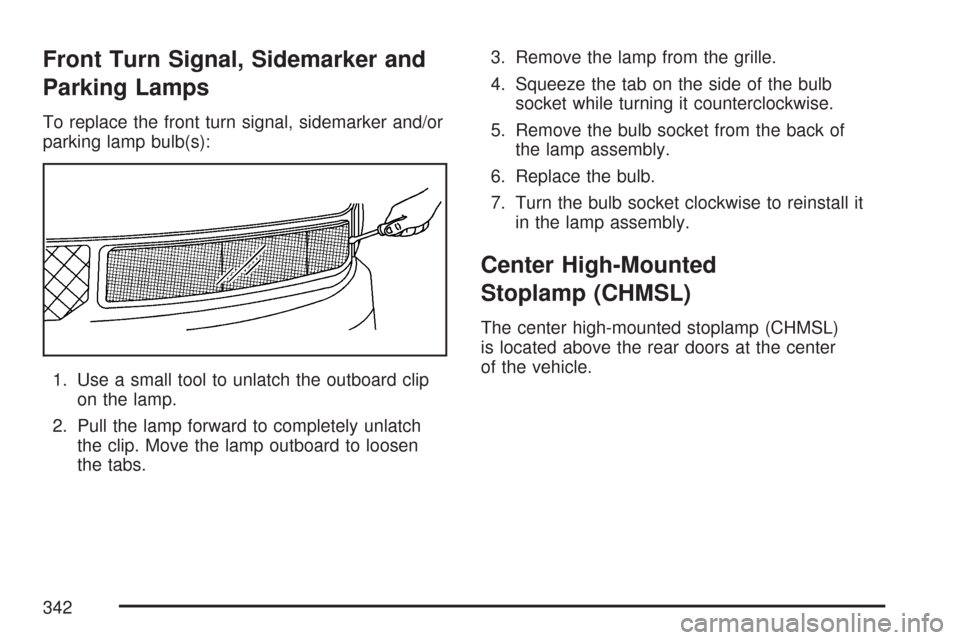
Front Turn Signal, Sidemarker and
Parking Lamps
To replace the front turn signal, sidemarker and/or
parking lamp bulb(s):
1. Use a small tool to unlatch the outboard clip
on the lamp.
2. Pull the lamp forward to completely unlatch
the clip. Move the lamp outboard to loosen
the tabs.3. Remove the lamp from the grille.
4. Squeeze the tab on the side of the bulb
socket while turning it counterclockwise.
5. Remove the bulb socket from the back of
the lamp assembly.
6. Replace the bulb.
7. Turn the bulb socket clockwise to reinstall it
in the lamp assembly.
Center High-Mounted
Stoplamp (CHMSL)
The center high-mounted stoplamp (CHMSL)
is located above the rear doors at the center
of the vehicle.
342